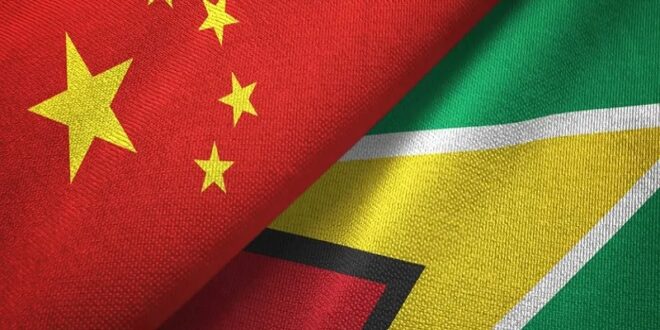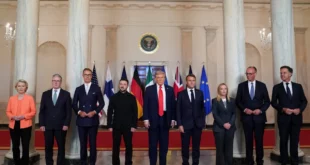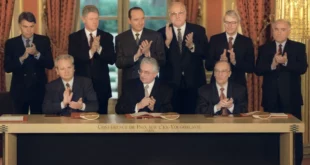None of the facts shared in this analysis should be spun as taking a side in the Venezuelan-Guyanese dispute, nor do they discredit critiques of Guyana’s energy ties with Exxon and its growing military ones with the US.
“The Venezuelan-Guyanese Dispute Is A Classic Security Dilemma” for the reasons argued in the preceding analysis, which should be read by those who aren’t familiar with them but can be summarized as the mutual mistrust between the two claimants and Venezuela’s of Guyana’s US partner. The informal Venezuelan-US dimension of this dispute has since prompted many of Caracas’ supporters to claim that Guyana is a US puppet due to its outsized dependence on Exxon for extracting oil from contested waters.
As was implied in the abovementioned analysis and will be expanded upon in the present piece, however, Guyana’s close ties with China challenge that description. For starters, Chinese Ambassador to Guyana Guo Haiyan said in May that Guyana had become China’s largest CARICOM trade partner after trade increased from $265 million in 2018 to $1.88 billion in 2022, which is a seven-fold expansion. 2018 was selected as the reference year since that’s when Guyana agreed to cooperate more with BRI.
Guyanese President Dr. Mohamed Irfaan Ali then traveled to Beijing in late July to meet with his Chinese counterpart, where they released a detailed joint statement that can be read here. He also gave two exclusive video interviews to CGTN that can be watched here and here, the second of which even saw him speak about “how he feels inspired by President Xi Jinping’s vision of shared global governance”. The reception that he received in China and his words while there clearly don’t comport with a US puppet’s.
Further evidence challenging that description can be found in the words of Guyanese Foreign Minister Hugh Todd, who revealed shortly after those two leaders’ meeting that China might participate in the joint Guyanese-Brazilian road project, which also happens to cut through disputed forested territory. If that happens, then Guyana would reap the fruits of Sino-Brazilian cooperation in South America, thus making it a de facto member of what Russian geo-economic guru Yaroslav Lissovolik calls BRICS+.
Ambassador Guo was so impressed by the outcome of President Ali’s meeting with his Chinese counterpart that she published an article in the Guyana Chronicle headlined “A new starting point for win-win cooperation and common development” in early August. Her upbeat expectations were then echoed in China Daily’s report from mid-October about how “China and Guyana forge ties for a bright future”, which was followed by Newsweek fearmongering about their trade ties in early November.
Almost exactly one month after China Daily’s report, China National Offshore Oil Company (CNOOC) announced that it commenced production in the Payara field of Guyana’s Stabroek Block, the latter of which is mostly located in disputed waters and is 25% owned by that Chinese company. It’s important to note that this announcement was made several weeks after Venezuela’s Electoral Council had already approved the five questions for early December’s referendum in late October.
After it was held, Chinese Foreign Minister Wang Yi said during a press conference that “Venezuela and Guyana are both China’s good friends. China always respects the sovereignty and territorial integrity of all countries. China always supports the two countries in properly settling the issue of demarcation of their boundary through friendly consultation. This is in the interests of the people of both countries and conducive to the stability, cooperation and development of Latin America and the Caribbean.”
Foreign Minister Wang’s words came the same day (6 December) as his American counterpart Antony Blinken pledged “unwavering support” for Guyana in a call with President Ali, which coincided with USSOUTHCOM announcing that it’ll conduct joint flights with that country the day after. Nevertheless, China’s position towards this dispute hasn’t changed in spite of Guyana’s growing military closeness towards the US in the aftermath of Venezuela’s referendum.
Observers might also be interested to know that those two’s positions are practically identical to Russia’s and Brazil’s. Regarding the first, Foreign Ministry spokeswoman Maria Zakharova said on 8 December that “We urge them to refrain from any actions that may unbalance the situation and harm both sides.” As for the second, President Luiz Inacio Lula da Silva told his Venezuelan counterpart Nicolas Maduro the day after that “it is important to avoid unilateral measures that lead to an escalation of the situation.”
That same day (9 December), St. Vincent and the Grenadines Prime Minister Ralph Gonsalves said in his capacity as president pro tempore of CELAC after his own call with President Maduro that he’ll host a meeting between him and President Ali next Thursday in which President Lula is invited as an observer. As can be seen, neither China, Russia, Brazil, nor CELAC (which doesn’t count the US as a member) treat Guyana as a US puppet, but instead as an equal partner with legitimate interests that deserve respect.
None of the facts shared in this analysis should be spun as taking a side in the Venezuelan-Guyanese dispute, nor do they discredit critiques of Guyana’s energy ties with Exxon and its growing military ones with the US. All that they do is challenge the description from many of Caracas’ supporters in the non-mainstream-media that Guyana is a US puppet whiling debunking the radical claim made by some that it’s a “fake country”, which in turn bolsters the argument that this is indeed a classic security dilemma.
 Eurasia Press & News
Eurasia Press & News




